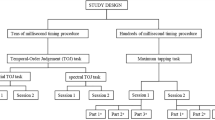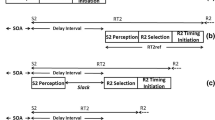Abstract
Intelligence is associated with accuracy in a wide range of timing tasks. One source of such associations is likely to be individual differences in top-down control, e.g., sustained attention, that influence performance in both temporal tasks and other cognitively controlled behaviours. In addition, we have studied relations between intelligence and a simple rhythmic motor task, isochronous serial interval production (ISIP), and found a substantial component of that relation, which is independent of fluctuations in top-down control. The main purpose of the present study was to investigate whether such bottom-up mechanisms are involved also in the relation between intelligence and reaction time (RT) tasks. We thus investigated whether common variance between the ISIP and RT tasks underlies their respective associations with intelligence. Two hundred and twelve participants performed a simple RT task, a choice RT task and the ISIP task. Intelligence was assessed with the Raven SPM Plus. The analysed timing variables included mean and variability in the RT tasks and two variance components in the ISIP task. As predicted, RT and ISIP variables were associated with intelligence. The timing variables were positively intercorrelated, and a principal component analysis revealed a substantial first principal component that was strongly related to all timing variables, and positively correlated with intelligence. Furthermore, a commonality analysis demonstrated that the relations between intelligence and the timing variables involved a commonality between the timing variables as well as unique contributions from choice RT and ISIP. We discuss possible implications of these findings and argue that they support our main hypothesis, i.e., that relations between intelligence and RT tasks have a bottom-up component.

Similar content being viewed by others
References
Berkson G, Baumeister AA (1967) Reaction time variability of mental defectives and normalcy. Am J Mental Deficiency 72:262–266
Coyle TR (2003) A review of the worst performance rule: evidence, theory and alternative hypotheses. Intelligence 31:567–587
D’Esposito M, Ballard D, Zarahn E, Aguirre GK (2000) The role of prefrontal cortex in sensory memory and motor preparation: an event-related fMRI study. Neuro Image 11:400–408
Deary IJ (2000) Looking down on human intelligence: from psychometrics to the brain. Oxford University Press, Oxford
Deary IJ, Der G, Ford G (2001) Reaction times and intelligence differences—a population-based cohort study. Intelligence 29:389–399
Forsman L, Madison G, Ullén F (2009) Neuroticism is correlated with drift in serial time interval production. Personal Individ Diff 47:229–232
Galton F (1908) Memories of my life. Methuen, London
Gilbert SJ, Simons JS, Frith CD, Burgess PW (2006) Performance-related activity in medial rostral prefrontal cortex (Area 10) during low-demand tasks. J Exp Psychol Hum Percept Perform 32:45–58
Gustafsson J-E (1984) A unifying model for the structure of intellectual abilities. Intelligence 8:179–203
Helmbold N, Rammsayer T (2006) Timing performance as a predictor of psychometric intelligence as measured by speed and power tests. J Individ Diff 27:20–37
Helmbold N, Troche S, Rammsayer T (2007) Processing of temporal and nontemporal information as predictors of psychometric intelligence: a structural-equation-modeling approach. J Personal 75:985–1006
Jensen AR (1992) The importance of intra individual variation in reaction-time. Personal Individ Diff 13:869–881
Jensen AR (1998) The g factor. Praeger Publishers, Westport
Jensen AR (2006) Clocking the mind: mental chronometry and individual differences. Elsevier, Oxford
Jensen AR, Weng L-J (1994) What is a good g? Intelligence 18:231–258
Jucaitė A, Dahlström A, Farde L, Forssberg H, Madison G (2008) Time production in children with ADHD: correlates to the central dopaminergic transmission. (submitted for publication)
Kampa BM, Letzkus JJ, Stuart GJ (2007) Dendritic mechanisms controlling spike-timing-dependent synaptic plasticity. Trends Neurosci 30:456–463
Keizer AW, Verschoor M, Verment RS, Hommel B (2010) The effect of gamma enhancing neuro feedback on the control of feature bindings and intelligence measures. Int J Psychophysiol 75:25–32
Kyllonen PC, Christal RE (1990) Reasoning ability is (little more than) working memory capacity?!. Intelligence 14:389–433
Lemmon VW (1927–1928) The relation of reaction time to measures of intelligence, memory, and learning. Arch Psychol 15:5–38
Lewis PA, Miall RC (2003) Distinct systems for automatic and cognitively controlled time measurement: evidence from neuroimaging. Curr Opin Neurobiol 13:250–255
Luce RD (1986) Response times—their role in inferring elementary mental organization. Oxford University Press, New York
Madison G (2001) Variability in isochronous tapping: higher-order dependencies as a function of inter tap interval. J Exp Psychol Hum Percept Perf 27:411–422
Madison G (2006) Duration-specificity in the long range correlation of human serial interval production. Physica D 216:301–306
Madison G, Delignières D (2009) Effects of auditory feedback on the long-range correlation of isochronous serial interval production. Exp Brain Res 193:519–527
Madison G, Merker B (2004) Human sensorimotor tracking of continuous subliminal deviations from isochrony. Neurosci Lett 370:69–73
Madison G, Forsman L, Blom Ö, Karabanov A, Ullén F (2009) Correlations between general intelligence and components of serial timing variability. Intelligence 37:68–75
Mallows CL (1973) Some comments on C p . Techno Metr 15:661–675
McGrew KS (2009) CHC theory and the human cognitive abilities project: standing on the shoulders of the giants of psychometric intelligence research. Intelligence 37:1–10
Pashler H (1994) Dual-task interference in simple tasks: data and theory. Psychol Bull 116:220–244
Plomin R (2006) The quest for quantitative trait loci associated with intelligence. Intelligence 34:513–526
Rammsayer TH, Brandler S (2002) On the relationship between general fluid intelligence and psychophysical indicators of temporal resolution in the brain. J Res Personal 36:507–530
Rammsayer TH, Brandler S (2007) Performance on temporal information processing as an index of general intelligence. Intelligence 35:123–139
Raven J, Raven JC, Court JH (2000) Manual for raven’s progressive matrices and vocabulary scales. Section 3: the standard progressive matrices. Harcourt Assessment, San Antonio
Repp BH (2005) Sensorimotor synchronization: a review of the tapping literature. Psychonom Bull Rev 12:969–992
Repp BH (2006) Does an auditory distractor sequence affect self-paced tapping? Acta Psychol 121:81–107
Rodgers P, Flower J, Stapleton G, Howse J (2010) Drawing area-proportional Venn-3 diagrams with convex polygons. In: Goel AK, Jamnik M, Narayanan MH (eds) Diagrams. Springer, Berlin, pp 54–58
Rowe JB, Toni I, Josephs O, Frackowiak RSJ, Passingham RE (2000) The prefrontal cortex: response selection or maintenance within working memory? Science 288:1656–1660
Schluter ND, Krams M, Rushworth MFS, Passingham RE (2001) Cerebral dominance for action in the human brain: the selection of actions. Neuropsychologia 39:105–113
Schweizer K, Moosbrugger H (2004) Attention and working memory as predictors of intelligence. Intelligence 32:329–347
Schweizer K, Moosbrugger H, Goldhammer F (2005) The structure of the relationship between attention and intelligence. Intelligence 33:589–611
Seibold DR, McPhee RD (1979) Commonality analysis: a method for decomposing explained variance in regression analyses. Hum Communic Res 5:355–365
Singer W (1999) Neuronal synchrony: a versatile code of the definition of relations? Neuron 24:49–65
Stankov L, Danthirr V, Williams LM, Pallier G, Roberts RD, Gordon E (2006) Intelligence and the tuning-in of brain networks. Learn Individ Diff 76:217–233
Telford CW (1931) The refractory phase of voluntary and associative responses. J Exp Psychol 14:1–36
Tiesinga P, Fellous J-M, Sejnowski TJ (2008) Regulation of spike timing in visual cortical circuits. Nat Rev Neurosci 9:97–107
Troche SJ, Rammsayer TH (2009) Temporal and non-temporal sensory discrimination and their predictions of capacity- and speed-related aspects of psychometric intelligence. Person Individ Diff 47:52–57. doi:10.1016/j.paid.2009.02.001
Ullén F, Madison G (2009) There is a bottom-up relation between temporal accuracy and intelligence—further arguments from studies of correlations between tapping variability and intelligence during high and low motivation. International Society for Intelligence Research, Madrid
Ullén F, Forsman L, Blom Ö, Karabanov A, Madison G (2008) Intelligence and variability in a simple timing task share neural substrates in the prefrontal white matter. J Neurosci 28:4238–4243
Zatorre RJ, Chen JL, Penhune VB (2007) When the brain plays music: auditory-motor interactions in music perception and production. Nat Rev Neurosci 8:547–558
Acknowledgments
This work was supported by the Swedish Research Council and the Freemasons in Sweden Foundation for Children’s Welfare. Part of this work was conducted under the European project COST ISCH Action TD0904 Time In MEntaL activitY: theoretical, behavioural, bioimaging and clinical perspectives (TIMELY; http://www.timely-cost.eu). We are grateful to Örjan de Manzano for comments on an earlier version of the manuscript.
Author information
Authors and Affiliations
Corresponding author
Rights and permissions
About this article
Cite this article
Holm, L., Ullén, F. & Madison, G. Intelligence and temporal accuracy of behaviour: unique and shared associations with reaction time and motor timing. Exp Brain Res 214, 175–183 (2011). https://doi.org/10.1007/s00221-011-2817-6
Received:
Accepted:
Published:
Issue Date:
DOI: https://doi.org/10.1007/s00221-011-2817-6




